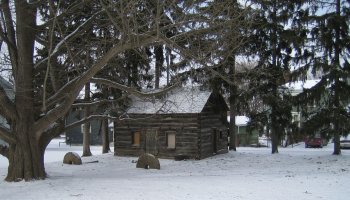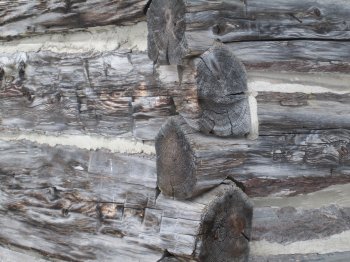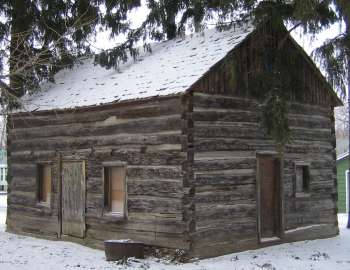- By Dan Veaner
- Around Town
 Print
Print
Lansing Town officials met Tuesday to strategize on how to bring the oldest log cabin in Tompkins and Cayuga Counties home to Lansing. Town Board members Bud Shattuck, Connie Wilcox, and Marty Christopher, Environmental Planner Darby Kiley, Codes Enforcement Office Dick Platt, and Highway Superintendent Jack French met with resident Chris Muka to decide how to get the cabin to Lansing from the Cayuga Museum in Auburn and where to put it. The museum had given the Town a deadline of January to remove the cabin from its property, but extended the time to allow the Lansing Highway Department better weather in which to effect the move. "We're going to bring it back," said Shattuck. "But there is no plan to put it together right away.

The North log cabin currently at the back of the Cayuga Museum lot
The cabin was built by the North family on a 600 acre tract of land that runs west from Conlon Road. While the original location can be traced to a specific tract which spans from Conlon to Salmon Creek Road, its exact location is not known. It is thought to be near the corner of Colon and Searles Roads on a farm that Walter Searles bought from Hiram Moe in 1853. Moe had purchased the property from Joseph North in 1839. In 1844 Daniel Tichenor moved the 18' x 24' cabin to 578 Conlon Road and it was eventually expanded to accommodate his family and covered with pine boards, hiding the nature of the original cabin for more than 100 years.
It wasn't until 1958 that the cabin was rediscovered when some of the pine boards were removed for repairs. An article in the Lansing Historical Association Newsletter says that in the early 20th century as many as six log cabins remained in Lansing, but the North cabin was the only one remaining when it was discovered in the late '50s. It was moved to Auburn in 1958 where it was used for exhibits. Eventually it was relegated to being a storage building, and recently the museum decided they wanted it removed.
The cabin is not only significant for being the oldest, but also because it was built by the North family that was influential in the early history of Lansing. According to former County Historian W. Glenn Norris, Roger North came to America from England in 1704, settling in Pennsylvania in 1750. Around 1799 his son Thomas moved to the Town of Milton, which at the time was part of Onondaga County. In 1799 the Town was relegated to the newly created Cayuga County. Thomas purchased the 600 acre lot 71 for $1,800 from John Lawrence. The lot had originally been granted to Captain Elias Van Benschotin in payment for his service in the Continental Army during the Revolutionary War.

Each log will have to be removed separately, because they
are notched at the corners to hold the structure together
In 1817 Tompkins County was created, and the southern half of Genoa, which contained the tract with the cabin, became the Town of Lansing. In the 1830s members of the North Family migrated to Ingram County in Michigan, acquiring a large tract of land there. Among other things they brought the name Lansing to their new home, now Michigan's State Capitol.
French said that he would take a look at the cabin this week to see what needs to be done to disassemble and transport it. The four walls are original, but the roof is not. There is a second floor with a stairway leading up to it. French estimated that it would take about a week to take it apart log by log, using a system Platt suggested to label each piece so that it can be accurately reassembled later. French predicted it would be transported to Lansing within the next three weeks, weather permitting.
But removing the cabin from Auburn is only half of the problem. The Town also needs a place to store it and eventually rebuild it to be displayed to the public. There is no budget for this project, and the original plan was to apply for grants before transporting the structure. The Highway Department is stepping in now because of the deadline imposed by the museum. The idea is to save this piece of Lansing's history, and then figure out what to do with it.
Originally officials hoped to find the original location, because they thought reassembling it there would make the project eligible for more grant funding. But after extensive research Shattuck and Muka could not pinpoint the exact location, because the cabin had been moved at least once before it ended up at the Conlon Road address.
Officials originally considered bringing the cabin to the town square that already houses the Town Hall, the historical Field one-room school house, a historical records building, the Lansing Community Center and the library, but it was decided not to put more buildings on that location. Several months ago Muka offered to donate about a half acre of land on Salmon Creek Road, which is part of the original 600 acre land tract.
With the museum's deadline making it urgent to move the cabin, Town officials have decided to accept Muka's offer. French planned to look at the tract Thursday to determine one location for storing the cabin, and another next to it where the cabin will eventually be erected. The group was concerned about storing the cabin for too long, worrying that the logs would rot. But the Town had no plan or budget to rebuild it.

"Do a quick site development on this land I have," suggested Muka. "Have a place where you can put it, and have a place where it's going to be built. Wherever you put it will eventually be a spot to park. There are about 300 people in the membership of the Ithaca United Soccer Club. I'm sure I could get healthy people in that club to get excited to help construct it. I think it should be constructed within a year. So if you can move it in less than a month and the site can be prepared with a foundation some time this summer, we can have it back together by Fall."
But when French looked over the property Wednesday morning he felt it probably wouldn't work. "It turned out that the property at Salmon Creek was too small, too much of a hill, too much dip off the road," Shattuck said Wednesday. "It just wasn't a plausible way to go."
French suggested an alternate location at the bottom of Myers Road. "Jack suggested that as a potential spot, because he thought that the Salmon Creek Road was too wet, and probably that the space was too shallow to have it there," Kiley explains. "It's actually pretty visible. I don't think it would be as picturesque as Salmon Creek Road, but people go by there, people walk by there."
Shattuck agrees that the location shows a lot of promise. "The first alternative right now is the Town's small gravel bank at the foot of Myers Road before you get to the railroad tracks on the left," he says. "That property is the Town of Lansing's and it's open, it's accessible -- it would really be a nice spot. It still ties that Ludlowville-Myers corridor in." He added that he was grateful for the offer of Muka's land. "I really hope that Chris stays involved, and works with us on other things -- maybe having the people he was talking about being in volunteer mode for the reassembly of the cabin," he said.
At this point the plan is about as Muka outlined, though at a different location. The timing has forced the Town to fly by the seat of its pants, but Muka's participation, some quick thinking, and Highway Department workers taking a bit of time in a slow period after the busy snow plowing season will preserve this oldest piece of Lansing history. "With our budget this is what's going to happen -- we'll put it someplace that's workable, that fits into the community," Shattuck says. "The Myers location seems like a good alternative, albeit early in the game. That's what we're looking at now and we'll look at other options as they come up."
----
v3i11

The North log cabin currently at the back of the Cayuga Museum lot
The cabin was built by the North family on a 600 acre tract of land that runs west from Conlon Road. While the original location can be traced to a specific tract which spans from Conlon to Salmon Creek Road, its exact location is not known. It is thought to be near the corner of Colon and Searles Roads on a farm that Walter Searles bought from Hiram Moe in 1853. Moe had purchased the property from Joseph North in 1839. In 1844 Daniel Tichenor moved the 18' x 24' cabin to 578 Conlon Road and it was eventually expanded to accommodate his family and covered with pine boards, hiding the nature of the original cabin for more than 100 years.
It wasn't until 1958 that the cabin was rediscovered when some of the pine boards were removed for repairs. An article in the Lansing Historical Association Newsletter says that in the early 20th century as many as six log cabins remained in Lansing, but the North cabin was the only one remaining when it was discovered in the late '50s. It was moved to Auburn in 1958 where it was used for exhibits. Eventually it was relegated to being a storage building, and recently the museum decided they wanted it removed.
The cabin is not only significant for being the oldest, but also because it was built by the North family that was influential in the early history of Lansing. According to former County Historian W. Glenn Norris, Roger North came to America from England in 1704, settling in Pennsylvania in 1750. Around 1799 his son Thomas moved to the Town of Milton, which at the time was part of Onondaga County. In 1799 the Town was relegated to the newly created Cayuga County. Thomas purchased the 600 acre lot 71 for $1,800 from John Lawrence. The lot had originally been granted to Captain Elias Van Benschotin in payment for his service in the Continental Army during the Revolutionary War.

Each log will have to be removed separately, because they
are notched at the corners to hold the structure together
In 1817 Tompkins County was created, and the southern half of Genoa, which contained the tract with the cabin, became the Town of Lansing. In the 1830s members of the North Family migrated to Ingram County in Michigan, acquiring a large tract of land there. Among other things they brought the name Lansing to their new home, now Michigan's State Capitol.
French said that he would take a look at the cabin this week to see what needs to be done to disassemble and transport it. The four walls are original, but the roof is not. There is a second floor with a stairway leading up to it. French estimated that it would take about a week to take it apart log by log, using a system Platt suggested to label each piece so that it can be accurately reassembled later. French predicted it would be transported to Lansing within the next three weeks, weather permitting.
But removing the cabin from Auburn is only half of the problem. The Town also needs a place to store it and eventually rebuild it to be displayed to the public. There is no budget for this project, and the original plan was to apply for grants before transporting the structure. The Highway Department is stepping in now because of the deadline imposed by the museum. The idea is to save this piece of Lansing's history, and then figure out what to do with it.
Originally officials hoped to find the original location, because they thought reassembling it there would make the project eligible for more grant funding. But after extensive research Shattuck and Muka could not pinpoint the exact location, because the cabin had been moved at least once before it ended up at the Conlon Road address.
Officials originally considered bringing the cabin to the town square that already houses the Town Hall, the historical Field one-room school house, a historical records building, the Lansing Community Center and the library, but it was decided not to put more buildings on that location. Several months ago Muka offered to donate about a half acre of land on Salmon Creek Road, which is part of the original 600 acre land tract.
With the museum's deadline making it urgent to move the cabin, Town officials have decided to accept Muka's offer. French planned to look at the tract Thursday to determine one location for storing the cabin, and another next to it where the cabin will eventually be erected. The group was concerned about storing the cabin for too long, worrying that the logs would rot. But the Town had no plan or budget to rebuild it.

"Do a quick site development on this land I have," suggested Muka. "Have a place where you can put it, and have a place where it's going to be built. Wherever you put it will eventually be a spot to park. There are about 300 people in the membership of the Ithaca United Soccer Club. I'm sure I could get healthy people in that club to get excited to help construct it. I think it should be constructed within a year. So if you can move it in less than a month and the site can be prepared with a foundation some time this summer, we can have it back together by Fall."
But when French looked over the property Wednesday morning he felt it probably wouldn't work. "It turned out that the property at Salmon Creek was too small, too much of a hill, too much dip off the road," Shattuck said Wednesday. "It just wasn't a plausible way to go."
French suggested an alternate location at the bottom of Myers Road. "Jack suggested that as a potential spot, because he thought that the Salmon Creek Road was too wet, and probably that the space was too shallow to have it there," Kiley explains. "It's actually pretty visible. I don't think it would be as picturesque as Salmon Creek Road, but people go by there, people walk by there."
Shattuck agrees that the location shows a lot of promise. "The first alternative right now is the Town's small gravel bank at the foot of Myers Road before you get to the railroad tracks on the left," he says. "That property is the Town of Lansing's and it's open, it's accessible -- it would really be a nice spot. It still ties that Ludlowville-Myers corridor in." He added that he was grateful for the offer of Muka's land. "I really hope that Chris stays involved, and works with us on other things -- maybe having the people he was talking about being in volunteer mode for the reassembly of the cabin," he said.
At this point the plan is about as Muka outlined, though at a different location. The timing has forced the Town to fly by the seat of its pants, but Muka's participation, some quick thinking, and Highway Department workers taking a bit of time in a slow period after the busy snow plowing season will preserve this oldest piece of Lansing history. "With our budget this is what's going to happen -- we'll put it someplace that's workable, that fits into the community," Shattuck says. "The Myers location seems like a good alternative, albeit early in the game. That's what we're looking at now and we'll look at other options as they come up."
----
v3i11



